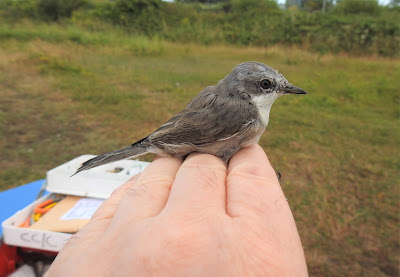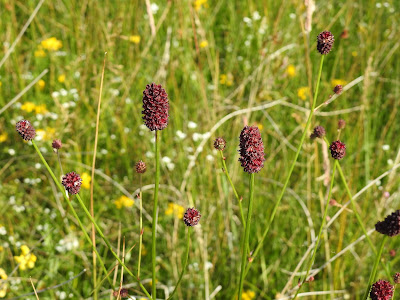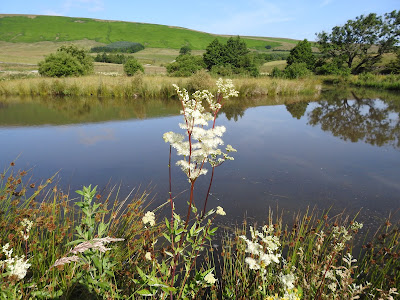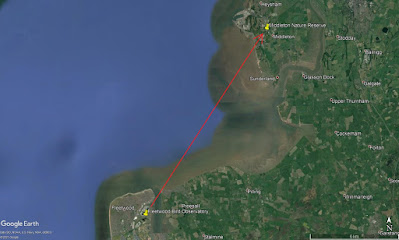Last Saturday, Alice and I had to furl our nets twice in the wet scrub at the Obs, but we still had a reasonable ringing session. When we put the nets up at 5:00 a.m. it was under full cloud cover, and the wind was a light south-easterly. It was a tad murky, and it wasn't forecast, but it was to become dreich!
We ringed 19 birds as follows (recaptures in brackets):
Great Tit - 1
Blackcap - 6
Robin - 1
Reed Warbler - 2 (4)
Blue Tit - 2
Lesser Whitethroat - 1
Sedge Warbler - 1
Whitethroat - 1 (1)
Willow Warbler - 1
Wren - 1
Dunnock - 1
Greenfinch - 1
One of the Reed Warblers that we captured, that was a breeding male, was ringed at the site in 2017 and hadn't been recaptured at all until last Saturday. In 2017, we ringed it as a '4' male, which means that it wasn't hatched during the calendar year of ringing, but could have been hatched any year previously. So, this means that the latest year that this bird hatched was in 2016, so he is at least five years old! Reed Warblers winter in tropical Africa, south of the Sahara, so just think how far this little fellow has flown, crossing the Sahara at least ten times, whilst only weighing 11-12 g. Amazing!
When I was heading back into the scrub to furl the nets for the first time, the Starlings were coming out of their roost, and I estimated the numbers to be somewhere in the region of 5,000 birds. I did wonder whether there was a Rose-coloured Starling amongst them, as the UK has seen a huge influx of them this summer.
From a birding perspective, there wasn't really much else to report. Whitethroats, Reed Warblers and Sedge Warblers are still holding territory, and singing away. In fact, a male Sedge Warbler close to the ringing station, sang and song-flighted his heart out, for the five hours we were on site! The scrape still held the juvenile Coots and Moorhens, and three House Martins and a couple of Swallows were hawking insects over the pool.
Towards the end of May I created a small pond in my garden (see pictures below). I say 'created', but it was really a case of digging the right sized hole, and putting the pre-formed plastic pond in said hole! It is only small as I said, but it is already attracting a few beasties. The pond itself has what looks like non-biting Midge (Chironomids) larvae in it, swimming up to the surface, and then diving down.
My small garden pond, and how it looked shortly after I put it in towards the end of May (above), and how it looks now, attracting a few beasties (below)
There are several Helophilus pendulus (I think) hoverflies knocking about around the pond, and assuming that is indeed what they are, they do like ponds and ditches! I've also recorded my first dragon at the pond, and that was a Blue-tailed Damselfly. So, I'm really pleased with that.
I was at my client's farm in Bowland yesterday checking some meadows for breeding Curlew, to make sure there were no chicks present prior to them being cut. We are hoping to start the process of restoring at least one meadow this year, and several more next year. We visited a neighbouring farm to look at some meadows/pastures that could act as a source for some donor seed, and they looked fantastic to say the least. The meadow was a riot of colour with species such as Yellow rattle, Knapweed, Meadow buttercup, Eyebright, Hawkbits, Meadowsweet, Meadow vetchling, Pignut, Ribwort plantain, Red clover, Selfheal and Bird's-foot trefoil to name but a few. The species-rich pasture was full of Common Spotted-orchids, with lesser numbers of Fragrant Orchid as well. Sadly, the weather was dreich to say the least yesterday, so I had to abandon any thought of getting any pictures. So, I'm really excited about getting this started.
There were no Curlew chicks in any of the meadows, but GT did pick up a juvenile flying with an adult, so that was evidence of successful outcome for one pair. A rather miserable looking Barn Owl was out attempting to hunt later in the morning when the rain had stopped. This was towards mid-day, so it shows how desperate it must have been to try and hunt at this time to feed its chicks.
Hopefully, I'll be out birding, ringing and botanising over the next few days. I'll keep you posted.



































